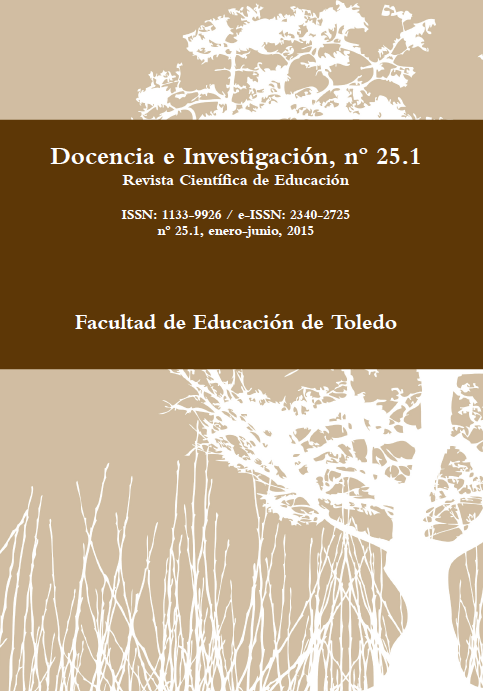Playing with words: L2 vocabulary acquisition and the use of popular tales. A perspective from the Involvement Load Hypothesis
Palabras clave:
aprendizaje de segunda lengua, cuentos populares, educación primaria, ILH, vocabularioResumen
Uno de los principales objetivos de la enseñanza en Educación Primaria en España es impulsar la adquisición de, al menos, una lengua extranjera. El vocabulario se considera uno de los aspectos clave para conseguir dicho objetivo. De hecho, se ha comprobado empíricamente que el conocimiento léxico ayuda a desarrollar habilidades comunicativas como la comprensión lectora o la producción escrita. Uno de los recursos utilizados para trabajar el léxico en lengua extranjera en el ámbito de Educación Primaria es la literatura infantil. De acuerdo con la ILH, el grado de implicación que exige una actividad puede incidir en el resultado de aprendizaje de quien la realiza. Nuestra propuesta pretende trabajar el vocabulario a través de una serie de actividades donde el vocabulario se trabaja con distintos grados de implicación según la ILH, tomando como base los cuentos populares.Referencias
Allen, V. (1983). Techniques in teaching vocabulary. New York: Oxford University Press.
Baddeley, A. (1997). Human Memory: Theory and Practice. London: Erlbaum.
Broeder, P. and Plunkett K. (1994). Connectionism and Second Language Acquisition. In Ellis, N. (Ed.). Implicit and explicit learning of languages (pp. 421-453). London: Academic Press.
Brown, C. (1993). Factors affecting the acquisition of vocabulary. In Huckin, T; Haynes, M. and Coady, J. (Eds.). Second Language Reading and Vocabulary (pp. 263-286). New Jersey: Ablex.
Colomer, T. (2010). Introducción a la literatura infantil y juvenil actual. Madrid: Síntesis.
Common European Framework of Reference for Languages (2001). Retrieved from http://www.coe.int/t/dg4/linguistic/source/framework_en.pdf
Ellis, N. (1994). Vocabulary Acquisition: the ins and outs of explicit cognitive mediation. In Ellis, N. (Ed.). Implicit and explicit learning of languages (pp. 211-282). London: Academic Press.
Ellis, N. and He, X. (1999). The roles of modified input and output in the incidental acquisition of word meanings. Studies in Second Language Acquisition, 21, 285-301.
Folse, K. (2006). The effect of type of written exercise on L2 vocabulary retention. TESOL Journal, 40, 273-293.
Golkar, M. and Yamini, M. (2007). Vocabulary, proficiency and reading comprehension. The Reading Matrix, 7, 88-112.
Hismanoglu, M. (2005). Teaching English through literature. Journal of Language and Linguistic Studies, 1, 53-66.
Hulstijn, J. and Laufer, B. (2001). Some empirical evidence for the Involvement Load Hypothesis in vocabulary acquisition. Language Learning 51, 539-558.
Jiménez Catalán, R.M. and Moreno Espinosa, S. (2005). Using Lex30 to measure the L2 productive vocabulary of Spanish primary learners of EFL. Vial, 13, 27-44.
Jiménez Catalán, R.M. and Terrazas, M. The receptive vocabulary of English foreign language young learners. IJES, 2, 201-215.
Keating, G. (2008). Task effectiveness and word learning in a second language: The involvement load hypothesis on trial. Language Teaching Research, 12, 365-386.
Laufer, B. (1986). Possible changes in attitude towards vocabulary acquisition research. IRAL, 24, 69-75.
Laufer, B. (1995). Beyond 2000: a measure of productive lexicon in a second language. In Eubank, L; Sharwood-Smith, M and Selinker, L. (Eds.). The current state of interlanguage (pp. 265-272). London: Benjamins.
Laufer, B. (1995). The development of passive and active vocabulary in a second language: same or different? Applied Linguistics, 19, 255-271.
Laufer, B. and Hulstijn, J. (2001). Incidental vocabulary acquisition in a second language: The construct of task-induced involvement. Applied Linguistics, 22, 1-26.
Lu, M. (2013). Effects of four vocabulary exercises on facilitating learning vocabulary meaning, form, and use. TESOL Quarterly, 47, 167-176.
McCarthy, M. (1990). Vocabulary. Oxford: Oxford University Press.
Manchón, R.M. (1987). Adquisición/aprendizaje de lenguas: el problema terminológico. Cuadernos de Filología Inglesa, 3, 37-47.
Meara, P. (1992). Network structures and vocabulary acquisition in a foreign language. In Arnaud, P. and Béjoint, H. (Eds.). Vocabulary and Applied Linguistics (pp. 62-70). London: McMillan.
Milton, J. (2009). Measuring second language vocabulary acquisition. Multilingual Matters: Bristol.
Nation, P. (2001). Learning vocabulary in another language. Cambridge: Cambridge University Press.
Nation, P. and Gu, P. (2007). Focus on vocabulary. Sydney: NCELTR.
Newton, J. (1995). Task-based interaction and incidental vocabulary learning: A case study. Second Language Research, 11, 159-177.
Quinn, G. (1968). The English vocabulary of some Indonesian University entrants. Salatiga: English Department Monograph IKIP Kristen Satya Watjana.
Read, J. (2000). Assessing vocabulary. Cambridge: Cambridge University Press.
Richards, J. (1974). Word lists: problems and prospects. RELC Journal, 5, 69-84.
Rodari, G. (2010). Gramática de la fantasía. Barcelona, España: Planeta.
Sell, J. (2005). Why teach literature in the foreign language classroom? Encuentro. Revista de investigación e innovación en la clase de lenguas, 15, 86-93.
Schmitt, N. (2000). Vocabulary in language teaching. Cambridge: Cambridge University Press.
Sparks, R. ; Ganschow, L. ; Patton, J.; Artzer, M.; Siebenhar, D.; and Plageman, M. (1997). Prediction of foreign language proficiency. Journal of Educational Psychology, 89, 549-561.
Takala, S. (1984). Evaluation of students’ knowledge of English vocabulary in the Finnish comprehensive school. Urbana: University of Illinois Press.
Descargas
Publicado
Número
Sección
Licencia
Política propuesta para Revistas que ofrecen Acceso AbiertoLos autores que publican en esta revista están de acuerdo con los siguientes términos:
- Los autores conservan los derechos de autor y garantizan a la revista el derecho de ser la primera publicación del trabajo al igual que licenciado bajo una Creative Commons Attribution License que permite a otros compartir el trabajo con un reconocimiento de la autoría del trabajo y la publicación inicial en esta revista.
- Los autores pueden establecer por separado acuerdos adicionales para la distribución no exclusiva de la versión de la obra publicada en la revista (por ejemplo, situarlo en un repositorio institucional o publicarlo en un libro), con un reconocimiento de su publicación inicial en esta revista.
- Se permite y se anima a los autores a difundir sus trabajos electrónicamente (por ejemplo, en repositorios institucionales o en su propio sitio web) antes y durante el proceso de envío, ya que puede dar lugar a intercambios productivos, así como a una citación más temprana y mayor de los trabajos publicados (Véase The Effect of Open Access) (en inglés).


